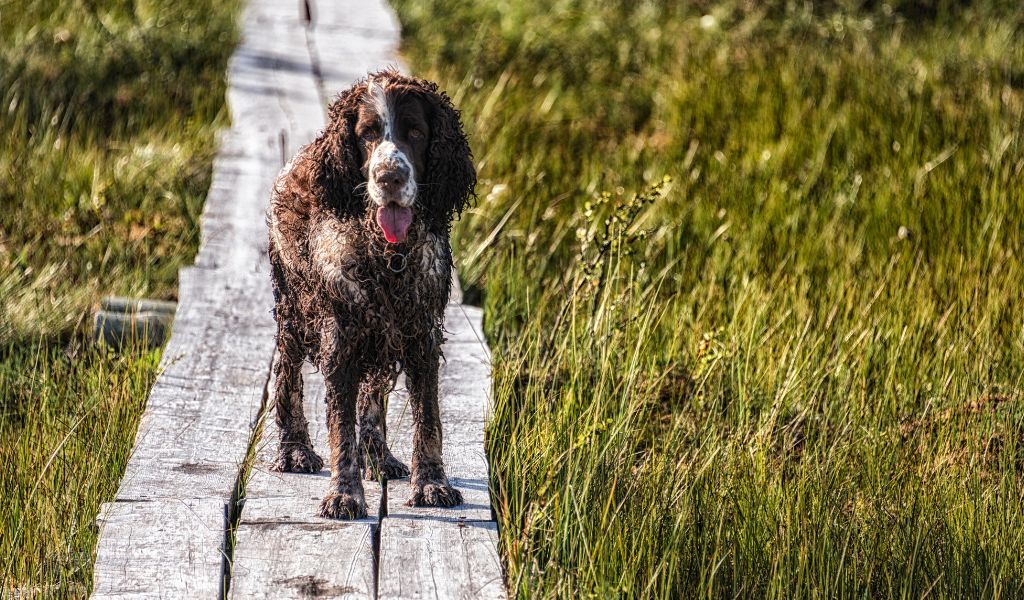In this article we’ll look at how to get a spaniel to come back to the whistle.
It’s an area that some people struggle with but, with a little bit of though and practice it’s not too difficult to get our dog to come back when told.
There are many things that we need to work on when we are training our spaniel, either as a working dog or as a pet.
Returning when needed and when told/asked is often a difficult aspect of training that some dog owners experience and find tricky to overcome.
In this article we’ll look at some ways to get your spaniel to come back to the whistle.
We’ve got more tips in our article on training a puppy which you can read here.

What is the recall command?
When we recall our spaniel we are telling him that we need him to come back to us – straightaway.
For a pet spaniel this might be when we are out for a walk and he is running free.
It could be that we are the end of the walk and we need to put him back on his lead.
There may be other reasons to get our spaniel back to us, maybe there are other dogs that we don’t want him near, or people.
Whatever the reason if we learn how to get a spaniel to come back to the whistle or other signal then we can control our dog more fully and he will be safer.
For a working spaniel the reasons for getting him to return to the whistle are the same as for a pet but also necessary when retrieving and when required by shooting or other conditions.
Regardless of the reasons behind needing our dog to return when called, this is an important area of spaniel training that you should focus upon.
It will aid other areas of training in the future and will help to keep you to keep your dog under control and safe.

Call your spaniel by his name to recall
From an early age, ideally as a puppy, when your spaniel comes home, you should introduce him to his name.
This will be the basis of how you get your spaniel to return, either when you call his name or, in the future when you use the whistle.
As a little pup, your spaniel will want to scamper around and play, all you need to do every now and then, is call his name, crouch down and, chances are he’ll come running up to you.
As soon as he does, make a great fuss of him, telling him what a great dog he is, stroking and fussing him.
Make a big deal of him coming when called.
Do this frequently and every time he comes to you make a great fuss of him.
Call his name and watch him run up, be excited to see him.
If, for some reason, your spaniel doesn’t come bounding up to you when you call his name, don’t panic.
The chances are that, for a young dog, he’s probably interested in a smell or something and that he’s distracted from you.

Do what you can to get his attention, shout his name, crouch down, make silly noises, wave something like one of his toys, get his attention.
If he still refuses to come, slowly run off in the other direction, calling his name as you do so.
He won’t want to be alone and the sight of you running away will be enough to get him after you.
As soon as he reaches you a massive fuss is needed from you to show him how pleased you are to see him.
In the event of him being particularly stubborn I would use an edible treat to reward him when he comes up.
I used this with Nimrod when he was little as, occasionally he would be reluctant.
The reward of a tasty treat soon fixed his reluctance and he now bounds in whenever called and whistled.
Using a check cord to get your dog to come back
Some trainers recommend the use of a cord, lightly fastened around the puppy to help them to get the dog to return.
I would only recommend this as a last resort and would combine the use of a cord with an edible treat when the dog comes in.
The way to use this is to fasten a lightweight cord gently around the dog’s neck or to his collar if he has one.
The cord needs to be around 30 feet in length. Let the dog free while you hold the other end of the cord.
Call his name, if he doesn’t return gently reel him in with the cord and give him a major reward when he gets to you.
As soon as he does this straightaway dispense with the cord and use the other techniques to call him to you.

Never chase your spaniel
Unless your spaniel is heading for danger and you cannot control him, you must never chase after him.
The safety of your dog is the most important thing and, there may be a time when you have to, literally, leg it after him, but, under normal circumstances you should not chase him.
If you get into the situation of chase then you dog will quickly view this as a great game to play and, generally he will win as, normally, you’ll be unable to get hold of him.
Chasing your dog unnecessarily will undo any training that you are doing to encourage the development of his recall.
Training a spaniel to come back to the whistle
Once your spaniel is returning reliably when you call his name, you are able to progress onto getting him to return to the whistle.
This is not a difficult step and is a simple progression in his training.
Firstly I’m assuming that you have a suitable whistle. I use the ACME range of whistles, I’ve always used them, they are solid, last years and I can get them delivered if I buy them via Amazon.
[amazon box=”B06XB2MT2Z” /]
The command for getting a spaniel to return to the whistle is a quick ‘peep, peep, peep, on the whistle.
Normally three peeps but, sometimes, you may need to do more.
Often this can be the case if it is windy, or if your dog is hunting hard.
Remember that he has to be able to hear the whistle and, if it’s windy or he is bashing in and out of cover then this may impede his ability to hear you.
Always try to see things from your spaniel’s perspective and don’t instantly assume that he is ignoring you.
The starting point for how to get a spaniel to come back to the whistle will need you to get to a place where the dog can’t get away from you easily.
Training your spaniel to come back to the whistle
Find a track, path, lane somewhere safe that preferably has fences or hedges on the sides and where there are few distractions.
Let your spaniel run free and allow him to scamper and sniff around.
When he is a short distance in front of you, call his name and blow three short ‘peeps’ on your whistle.
Now if he’s reliable at coming when you call his name then he should come running in quickly. If he does then praise him and make a fuss of him.
If he doesn’t then call his name again, get his attention, blow the whistle and run off in the opposite direction.
The reason that we use a path is so that he cannot run away easily and he’s left with little option but to come to you.
With practice and patience your spaniel will soon return to the whistle when you need him to.
If he’s showing reluctance to come to you, an edible treat now and again is a good way to get him to enjoy this exercise.
Make it tasty and after a few successful returns, limit the amount of times when you give him a treat, so he doesn’t know when to expect one.

Introduce recall to the whistle daily
It’s important to continue with your spaniel’s recall when out and about on walks or when training and doing other exercises.
If your dog is running free then it’s a relatively easy task to whistle him up to you occasionally.
When you do this and he gets to you, praise him then head off in a different direction.
This reinforces your position as the leader of the pack and also demonstrates to your spaniel that when he comes back you are going to do something interesting ( in this case exploring new things in a different direction).
You can do this in training too. When your spaniel is hunting, call him in with the whistle, make him hup ( sit ), wait a moment or two, and then head off in a different direction.
By showing him that when he comes back he gets rewarded ( stroked, called a good dog, edible reward etc) and he then gets to do something else that is interesting too. ( we’re just trying to think a bit like a dog ).
What to do when a spaniel won’t come back
If our spaniel is normally compliant and comes when called or whistled, then, if he doesn’t return when you tell him one of two things has occurred.
He either hasn’t heard you – maybe it’s windy or he’s crashing around making your voice or whistle difficult to hear, you must make sure that any commands that you give to your spaniel are clear to him.
The second matter is that he isn’t obeying and he’s ignoring you and you need to deal with it.
This is the one occasion where you need to get after him.
Making as much noise as possible with a gruff voice, you need to run him down and stop him in his tracks. It may take some effort but you’ve got to catch him and stop him.
Once you’ve got him, repeat the whistle command in his ear and show your general displeasure at having to chase him.
You don’t need to hit or smack him or be physical with him, the sound of your voice should be enough.
Sit him down, walk backwards from him and, after a few moments, blow the whistle three times ( short peeps) and encourage him to you. Praise him, then do it again, put the lead on and take him home.
Always end on a positive note and be aware of him next time that you are out – that he tried it and you had to correct him.
Learn from your times out with him and try to anticipate any potential problems before they can occur.
We have more information and videos to help you to train a spaniel to come back in this article.
Final Words
Be consistent and take your time with your dog. If it isn’t going well then take some time out and do something that your dog is good at.
Always aim to finish on a positive note.




